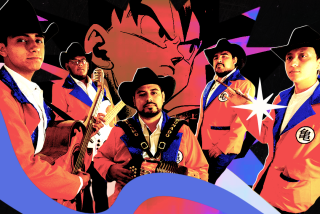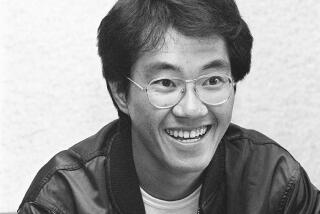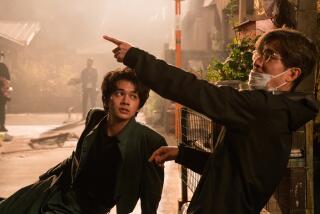For manga, a novel approach
- Share via
AMERICAN kids may have the reputation of not liking to read, but thousands of them are devouring the adventures of their favorite manga and anime characters in translated novelizations that have begun appearing in the U.S. Popular examples include the daring adventures of the sorcerer brothers Edward and Alphonse Elric (“Fullmetal Alchemist”) and samurai Kenshin Himura (“Rurouni Kenshin”), the comic misadventures of gay rock star Shuichi Shindo (“Gravitation”) and the saga of knuckleheaded ninja-in-training Naruto Uzumaki (“Naruto”).
Japanese graphic novels, or manga, represent the fastest-growing segment of U.S. publishing: According to several reports, American sales tripled from 2002 to 2005 and increased to $205 million in 2006. Manga titles regularly appear on the Publisher’s Weekly and USA Today bestseller lists. Its core audience, according to publisher Mike Kiley of TokyoPop Inc., is 13 to 24 years old.
Richard Lu, vice president of publishing at Viz Media, said the audience is “fairly balanced between male and female readers.”
The practice of adapting stories from manga and animation to prose has been growing in Japan. As Roland Kelts, the author of “Japanamerica: How Japanese Pop Culture Has Invaded the U.S.,” put it, “What’s happening in Japan is that the shift from novelists to manga writers has gone backwards. Now you have established manga writers writing novels and publishing imprints capitalizing on this trend.”
Manga-based novels take different forms: The simplest are straightforward retellings of adventures from the original graphic novel or animation. “Naruto: Innocent Heart, Demonic Blood” (Viz) repeats material from the first volumes of the manga and animated episodes: Naruto and his classmates begin their ninja training, learn magical jutsu (techniques) and go on their first mission. “Fullmetal Alchemist: The Land of Sand” (Viz) retells Episodes 11 and 12 of the animated series, the clash between the real Edward and Alphonse and two amateur alchemists who pose as the famous Elric Brothers. The change in medium invariably results in shifts in emphasis; “Land of Sand” author Makoto Inoue creates a stronger, sympathetic bond between Alphonse and Fletcher, the younger of the two false Elrics.
Other authors use familiar characters in new stories, adding plot twists not found in the drawn and animated versions.
Japanese writers and readers describe these books as “light novels,” recognizing that they’re not serious literature. In English, they read like a cross between the pulp fiction of the ‘40s and the juvenile novels of the postwar decades. Yet the manga characters often display greater depth. Nancy Drew never had to choose between violating an oath never to kill again and preventing a coup d’etat that could result in thousands of deaths, as Kenshin does.
Following the lead of their Japanese counterparts, American publishers are expanding their slates of manga-based novels. According to Kiley, “This year, we’ll publish about three dozen novels, and probably between 40 and 50 in 2008. This is a major commitment for us.”
America has a long way to grow before sales approach the astronomical levels of manga and manga-related books in Japan, where the first 16 volumes of the “Fullmetal Alchemist” have sold more than 27 million copies. But publishers can dream.
“In Japan, manga are for everyone.... It’s not unrealistic to think that in time we can capture an older audience,” said Gonzalo Ferreyra, Viz vice president of sales. “I gave my 65-year-old father-in-law the first ‘Fullmetal Alchemist’ manga, now he’s addicted.”
More to Read
Sign up for our Book Club newsletter
Get the latest news, events and more from the Los Angeles Times Book Club, and help us get L.A. reading and talking.
You may occasionally receive promotional content from the Los Angeles Times.










